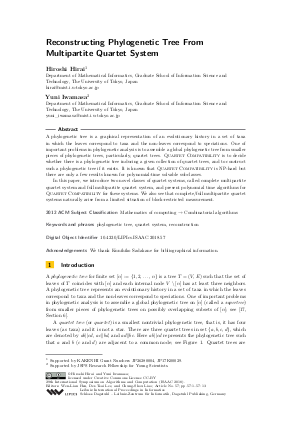Reconstructing Phylogenetic Tree From Multipartite Quartet System
Authors Hiroshi Hirai, Yuni Iwamasa
-
Part of:
Volume:
29th International Symposium on Algorithms and Computation (ISAAC 2018)
Part of: Series: Leibniz International Proceedings in Informatics (LIPIcs)
Part of: Conference: International Symposium on Algorithms and Computation (ISAAC) - License:
 Creative Commons Attribution 3.0 Unported license
Creative Commons Attribution 3.0 Unported license
- Publication Date: 2018-12-06
File

PDF
LIPIcs.ISAAC.2018.57.pdf
- Filesize: 1.85 MB
- 13 pages
Document Identifiers
Subject Classification
ACM Subject Classification
- Mathematics of computing → Combinatorial algorithms
Keywords
- phylogenetic tree
- quartet system
- reconstruction
Metrics
- Access Statistics
-
Total Accesses (updated on a weekly basis)
0Document
0Metadata
Abstract
A phylogenetic tree is a graphical representation of an evolutionary history in a set of taxa in which the leaves correspond to taxa and the non-leaves correspond to speciations. One of important problems in phylogenetic analysis is to assemble a global phylogenetic tree from smaller pieces of phylogenetic trees, particularly, quartet trees. Quartet Compatibility is to decide whether there is a phylogenetic tree inducing a given collection of quartet trees, and to construct such a phylogenetic tree if it exists. It is known that Quartet Compatibility is NP-hard but there are only a few results known for polynomial-time solvable subclasses. In this paper, we introduce two novel classes of quartet systems, called complete multipartite quartet system and full multipartite quartet system, and present polynomial time algorithms for Quartet Compatibility for these systems. We also see that complete/full multipartite quartet systems naturally arise from a limited situation of block-restricted measurement.
Cite As Get BibTex
Hiroshi Hirai and Yuni Iwamasa. Reconstructing Phylogenetic Tree From Multipartite Quartet System. In 29th International Symposium on Algorithms and Computation (ISAAC 2018). Leibniz International Proceedings in Informatics (LIPIcs), Volume 123, pp. 57:1-57:13, Schloss Dagstuhl – Leibniz-Zentrum für Informatik (2018)
https://doi.org/10.4230/LIPIcs.ISAAC.2018.57
BibTex
@InProceedings{hirai_et_al:LIPIcs.ISAAC.2018.57,
author = {Hirai, Hiroshi and Iwamasa, Yuni},
title = {{Reconstructing Phylogenetic Tree From Multipartite Quartet System}},
booktitle = {29th International Symposium on Algorithms and Computation (ISAAC 2018)},
pages = {57:1--57:13},
series = {Leibniz International Proceedings in Informatics (LIPIcs)},
ISBN = {978-3-95977-094-1},
ISSN = {1868-8969},
year = {2018},
volume = {123},
editor = {Hsu, Wen-Lian and Lee, Der-Tsai and Liao, Chung-Shou},
publisher = {Schloss Dagstuhl -- Leibniz-Zentrum f{\"u}r Informatik},
address = {Dagstuhl, Germany},
URL = {https://drops.dagstuhl.de/entities/document/10.4230/LIPIcs.ISAAC.2018.57},
URN = {urn:nbn:de:0030-drops-100056},
doi = {10.4230/LIPIcs.ISAAC.2018.57},
annote = {Keywords: phylogenetic tree, quartet system, reconstruction}
}
Author Details
- Department of Mathematical Informatics, Graduate School of Information Science and Technology, The University of Tokyo, Japan
Funding
- Hirai, Hiroshi: Supported by KAKENHI Grant Numbers JP26280004, JP17K00029.
- Iwamasa, Yuni: Supported by JSPS Research Fellowship for Young Scientists.
References
-
A. V. Aho, Y. Sagiv, T. G. Szymanski, and J. D. Ullman. Inferring a tree from lowest common ancestors with an application to the optimization of relational expressions. SIAM Journal on Computing, 10(3):405-421, 1981.

-
H.-J. Bandelt and A. Dress. Reconstructing the shape of a tree from observed dissimilarity data. Advances in Applied Mathematics, 7:309-343, 1986.

-
V. Berry, D. Bryant, T. Jiang, P. Kearney, M. Li, T. Wareham, and H. Zhang. A practical algorithm for recovering the best supported edges of an evolutionary tree. In Proceedings of the 11th ACM-SIAM Symposium on Discrete Algorithms (SODA'00), pages 287-296, 2000.

-
V. Berry, T. Jiang, P. Kearney, M. Li, and T. Wareham. Quartet cleaning: Improved algorithms and simulations. In Proceedings of the 7th European Symposium on Algorithm (ESA'99), volume 1643 of Lecture Notes in Computer Science, pages 313-324, Heidelberg, 1999. Springer.

-
D. Bryant and M. Steel. Extension operations on sets of leaf-labelled trees. Advances in Applied Mathematics, 16:425-453, 1995.

-
P. Buneman. The recovery of trees from measures of dissimilarity. In F. R. Hodson, D. G. Kendall, and P. Tautu, editors, Mathematics in the Archaeological and Historical Science, pages 387-395. Edinburgh University Press, 1971.

-
M.-S Chang, C.-C Lin, and P. Rossmanith. New fixed-parameter algorithms for the minimum quartet inconsistency problem. Theory of Computing Systems, 47(2):342-367, 2010.

-
H. Colonius and H. H. Schulze. Tree structure from proximity data. British Journal of Mathematical and Statistical Psychology, 34:167-180, 1981.

-
W. M. Fitch. A non-sequential method for constructing trees and hierarchical classifications. Journal of Molecular Evolution, 18:30-37, 1981.

-
J. Gramm and R. Niedermeier. A fixed-parameter algorithm for minimum quartet inconsistency. Journal of Computer and System Sciences, 67:723-741, 2003.

- H. Hirai, Y. Iwamasa, K. Murota, and S. Živný. A tractable class of binary VCSPs via M-convex intersection. arXiv, 2018. URL: http://arxiv.org/abs/1801.02199v1.
-
T. Jiang, P. Kearney, and M. Li. A polynomial time approximation scheme for inferring evolutionary trees from quartet topologies and its application. SIAM Journal on Computing, 30(6):1942-1961, 2001.

-
R. Reaz, M. S. Bayzid, and M. S. Rahman. Accurate phylogenetic tree reconstruction from quartets: A heuristic approach. PLoS ONE, 9(8):e104008, 2014.

-
S. Sattath and A. Tversky. Additive similarity trees. Psychometrika, 42(319-345), 1977.

-
A. Schrijver. Combinatorial Optimization: Polyhedra and Efficiency. Springer, Heidelberg, 2003.

-
C. Semple and M. Steel. A supertree method for rooted trees. Discrete Applied Mathematics, 105:147-158, 2000.

-
C. Semple and M. Steel. Phylogenetics. Oxford University Press, Oxford, 2003.

-
M. Steel. The complexity of reconstructing trees from qualitative characters and subtrees. Journal of Classification, 9:91-116, 1992.

-
K. Strimmer and A. Haeseler. Quartet puzzling: A quartet maximum-likelihood method for reconstructing tree topologies. Journal of Molecular Biology and Evolution, 13:964-969, 1996.

